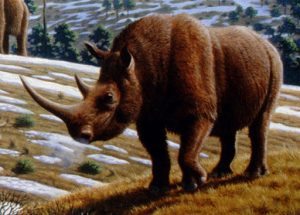Woolly rhinoceros
(Coelodonta antiquitatis)
- This was an extinct species of rhinoceros that was common throughout Europe and northern Asia during the Pleistocene epoch.
- Its body was covered with long, thick hair that allowed it to survive in the extremely cold, harsh mammoth steppe.
- Carcasses preserved in permafrost and many bone remains of woolly rhinoceroses have been found.
- Images of woolly rhinoceroses are found among cave paintings in Europe and Asia.
-
- Size
Head to tail length – 3m
Shoulder height – 2 m
Weight – around 1800 – or 2000 kg.
Compared to other rhinoceroses, the woolly rhinoceros had a longer head and body, and shorter legs.
Both sexes had two horns made of keratin, the long horn was placed in the front, and a smaller horn between the eyes.
It had a massive hump reaching from its shoulder and that used to support the animal’s massive front horn.
- Its massive lower jaw measured up to 60 cm long and 10 cm high.
- Their nasal septum was ossified, unlike the modern rhinos. This adaptation probably evolved as a result of the heavy pressure of the horn on the face when they grazed underneath the thick snow.
- Unique to this rhino, the nasal bones were fused to the premaxillae, which is not the case in older Coelodonta types or today’s rhinoceroses.
- The teeth of the woolly rhinoceros had thickened enamel and an open internal cavity. Like other rhinos, adults did not have incisors. It had 3 premolars and 3 molars in both jaws. The molars were high-crowned and had a thick coat of cementum.
- It mostly fed on grasses and sedges that grew in the mammoth steppe.
- With their massive horns and size, adults had few predators, but young individuals could be attacked by animals such as hyenas and cave lions.
- Woolly rhinoceros remains have been known long before the species was described, and were the basis for myths.
- Native peoples of Siberia believed their horns were the claws of giant birds. Based on this assumption Gotthilf Heinrich von Schubert classified the animal under the name Gryphus antiquitatis, meaning “ancient griffin”.
- 1769 – Naturalist Peter Simon Pallas on his expeditions to Siberia found a skull and two horns in the permafrost. Based on this one of the earliest scientific descriptions of an ancient rhinoceros species was reported.
- 1772 – Pallas acquired a head and two legs of a rhinoceros from the localsin Irkutsk, and named the species Rhinoceros lenenesis (after the Lena River).
- 1799 – Johann Friedrich Blumenbach studied rhinoceros bones from the collection of the University of Göttingen, and proposed the scientific name Rhinoceros antiquitatis.
- 1831 – Geologist Heinrich Georg Bronn moved the species to Coelodonta because of its differences in dental formation with members of the Rhinoceros genus. This name comes from the Greek words (koilía, “cavity”) and (odoús “tooth”), from the depression in the molar structure, giving the scientific name Coelodonta antiquitatis, “ancient hollow tooth”.
- Causes of Extinction
- Human hunting is often cited as one cause.
- Other theories for the cause of the extinctions are climate change associated with the receding Ice age and the hyperdisease hypothesis.
- Radiocarbon dating indicates that populations survived as recently as 8,000 BC in western Siberia.
